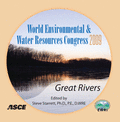Environmental Impacts on Surface Water and Groundwater for Expanding Urban Water Supply Capacity Using Stone Quarries
Publication: World Environmental and Water Resources Congress 2009: Great Rivers
Abstract
Global climate change and its related impacts on water supply are universally recognized. In the past few years, drought impacts affecting big metropolitan water supplies alone have plagued Maryland and the Chesapeake Bay in 2001 through 2002, Lake Mead in Las Vegas in 2000 through 2004, the Peace River and Lake Okeechobee in South Florida in 2006, and Lake Lanier in Atlanta in 2007 that especially affected the water resources distribution in three states — Alabama, Florida, and Georgia. One group of unnatural sites, namely crushed stone quarries, holds promise for expanding the reservoir capacity in water supply systems. Inspired by the past and future trend of global change and the need to generate adaptive water resources management strategies, this study develops the conceptual and numerical framework of a spatial decision support system for evaluating the feasibility of water supply development using abandoned and active stone quarries. Whether or not a particular abandoned or active quarry can be used as a water supply reservoir depends on many different factors. Some important factors are the size of a quarry and the volume of water that can be stored, the location of a quarry and its distance to the city or community that needs water supply, the source of water that can be diverted into a quarry, surface runoff input from watershed to quarry, evaporative loss of water in quarry, and groundwater input to quarry. Water storage and recharge in the aquifers must be achieved with caution since water quality may be changed by biogeochemical reactions with aquifer materials. We demonstrate in two cases that mixing of recharge water and groundwater of different hydrochemistry may dissolve certain minerals while allow others to precipitate in the aquifers. A quarry reservoir can become thermal stratification during summer if it is deep enough, and the stratification can lead to oxygen depletion in the bottom waters, and then it may require hypolimnetic oxygenation (aeration) to improve water quality. A lake water quality model is used to examine water quality dynamics in different types of stone quarry reservoirs under different climate and watershed input scenarios.
Get full access to this article
View all available purchase options and get full access to this chapter.
Information & Authors
Information
Published In
Copyright
© 2009 American Society of Civil Engineers.
History
Published online: Apr 26, 2012
ASCE Technical Topics:
Authors
Metrics & Citations
Metrics
Citations
Download citation
If you have the appropriate software installed, you can download article citation data to the citation manager of your choice. Simply select your manager software from the list below and click Download.
